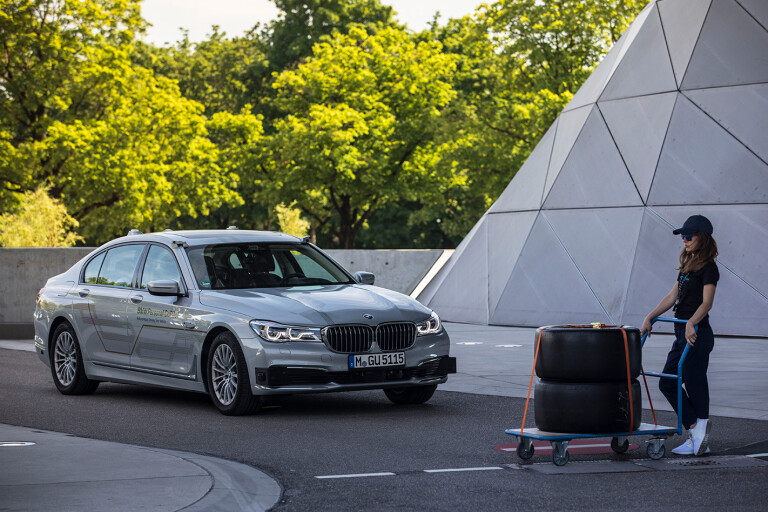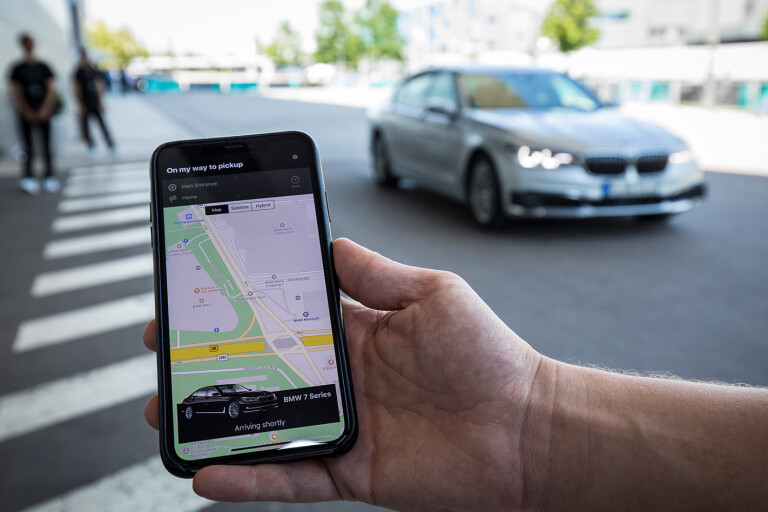.jpg )
BMW has cemented yet another milestone in the fully autonomous vehicle story with a special 7 Series prototype that demonstrates level-four driverless capability.
The German car maker’s first production model with the level-three badge of honour will arrive in 2021 when the showroom version of the BMW iNext concept touches down, but the specially modified 7 Series is providing an early glimpse at the next step beyond that.

While the yet-to-be-named large SUV’s level-three systems will be able to negotiate freeways without intervention, a human driver will need to take the wheel once the vehicle re-enters more complicated suburban roads.
But level-four equipped models will not need to hand over control when the freeway ends for true door-to-door autonomy.
We jumped on board the revolutionary 7 Series during BMW’s NextGen technology event in Munich, for a first look at how the vehicles of the future won’t rely on a human to drive them at all.
Put simply, BMW’s Personal CoPilot system works exactly like Uber, minus the driver.
A smartphone application allows the user to summon the 7 Series to their location for the start of a journey. In our case, the pick-up point was in the shadow of BMW Welt in the south of Germany, with the prototype parked just a short distance across a courtyard.

With the tap of a button, the hybrid limo glided across the concrete and sat obediently waiting for the application to tell it to unlock – again, with a tap of an onscreen prompt.
Then it was simply a matter of boarding and hitting the ‘start’ icon in the centre of a large central screen that had been added as part of the prototype kit. The car asks for no address information because it has already uploaded the destination from the initial application request.
For the purposes of this short demonstration, a lap of the building had been preprogrammed, and the 745Le quietly pulled away once it had established all occupants had fastened their seatbelts.
In the interest of allowing engineer Phillip enough time to explain exactly what was happening, the car had been asked to travel at walking pace, but its series of LIDAR, radar, cameras and GPS devices gather massive amounts of information from its surroundings, enabling the test to happen at much higher speeds if required.
The vast quantity of data is processed by the vehicle’s sophisticated systems, enabling it to build a picture of the world around it. Additional screens have been installed for the test allowed occupants to see a graphic representation of its vision or – “a window into its mind,” says Phillip.
Rather than simply following a predetermined route, the 7 Series has only the destination as its instruction, deciding the best way to get there all by itself using navigation information as well as its banks of sensors.

If anything unexpected or un-mapped should happen along the way, the Personal CoPilot system is able to adapt to the situation. Right on cue, a pedestrian wheeling a trolley steps out in front of the car, bringing it to a halt.
While this same demonstration had been carried out many times already, the car is not expecting the hazard and is simply responding to an event similar to what it may encounter on any given day in an unpredictable public environment.
And this is the key difference between level-three and level-four autonomous driving. A freeway is a far more controlled landscape with all traffic travelling in the same direction, at approximately the same speed, and with a lower likelihood of complex traffic or hazard scenarios.
But a suburban arena is immensely complicated by comparison, with pedestrians, cyclists, and traffic flowing in all directions, through traffic management lights and signs and at all different speeds including zero.
Understandably, a privately owned car with level-four autonomy is a while away yet but, speaking to WhichCar at the NextGen event, BMW member of the board of management, customer, brands and sales, Pieter Nota, confirmed that level-three will soon be a reality in a car you can buy.
“The iNext that we will launch in 2021 is already planned to have level three autonomous driving capability,” he said. “That means on highways you would be able to drive from Munich to Hamburg on the autobahn in autonomous mode. It will be able to completely take over from the driver."
The only small caveat to level-four is that it reserves the right to ask for assistance if something presents too much of a challenge, and a driver must be ready to take back control in an emergency.
But even more distant than level-four is the self-driving holy grail in which a vehicle can negotiate the most challenging environments during all weather conditions, light levels and unforeseeable occurrences – level five.

“Level five is still quite far out,” admitted Nota. “My home town is Amsterdam, and the day that you can really drive fully automated in Amsterdam where there is a bike falling in front of your nose every other second, that is still quite far out. I don’t want to set up the illusion that we will be able to tackle that in 2021.
“We have to be realistic about the advancement of these capabilities, but what is important is that if, for example, cities engage in geofencing, of course these capabilities are much closer because you avoid that bike. It is separated.”
In the 7 Series’ inviting cabin, our test ‘drive’ has concluded. Despite having no one in the driver’s seat, the car has parked back at the pick-up point after a flawless lap of the impressive building.
After leaving the vehicle, one final tap of the smartphone sends the big BMW gliding off to its carpark, which could for all intents and purposes be your basement carpark or a new pick-up location.
There are still some serious hurdles to overcome before this technology will be offered to the public, including the legislation to allow these vehicles to operate without a driver – ironically, the limiting factor, as the Personal CoPilot demonstrates, is not the technology.
But a brief trip in the most advanced 7 Series to date does conclusively prove that what was once a fantasy limited to the big screen, will one day become a reality. Or will it?


COMMENTS